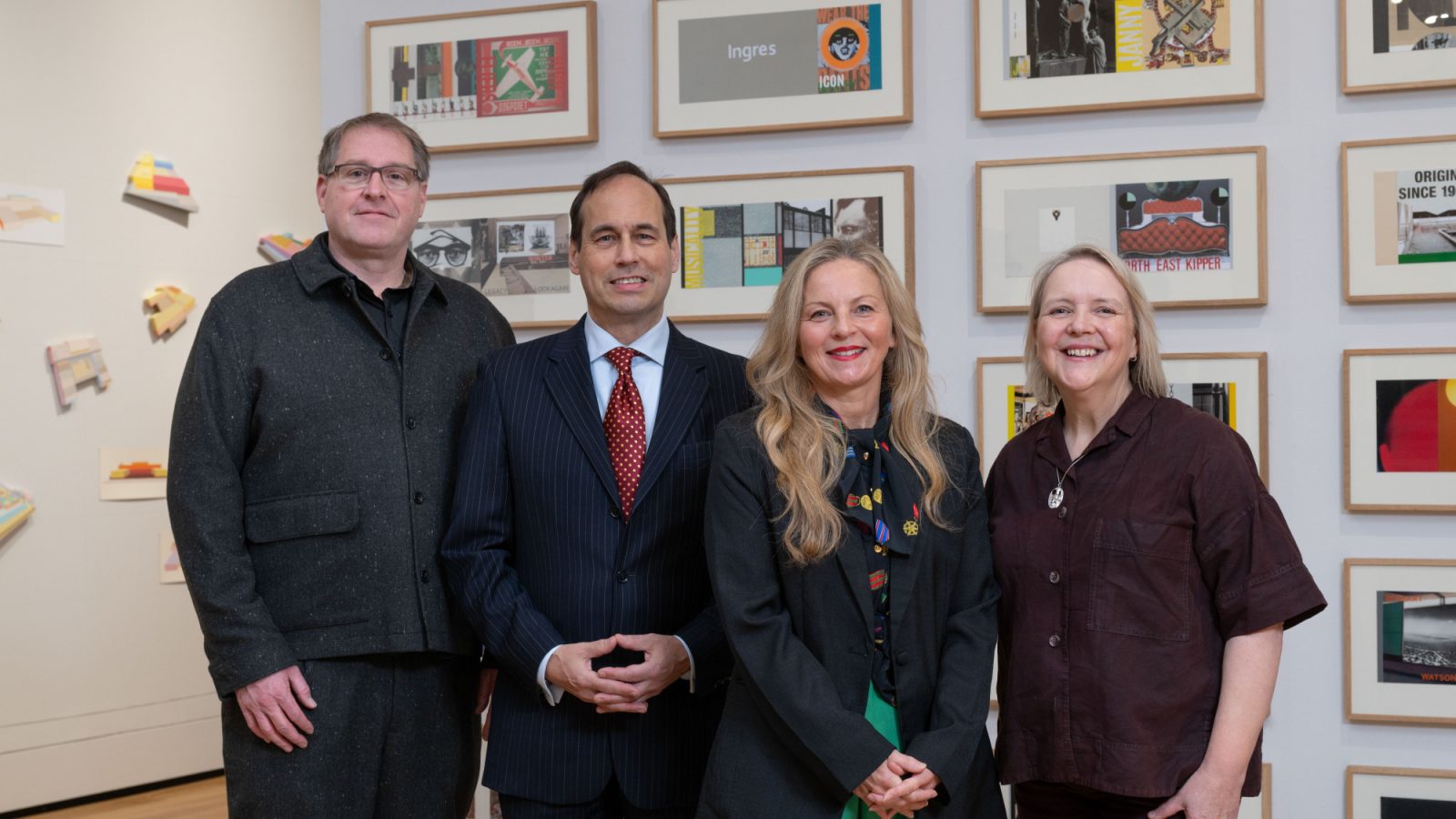140 years of artist-led education at Gray’s School of Art is being celebrated in a major new exhibition at Aberdeen Art Gallery.
Featuring works by over 50 artists – all of whom studied or worked at Gray’s – the exhibition focuses on the art school environment: on what artists teach, how ideas are passed from generation to generation, and how studio culture continues to evolve.

Professor Dan Allen, Dean of Gray’s School of Art, Councillor Martin Greig, Aberdeen City Council’s culture spokesperson, and exhibition co-curators Sally Reaper and Dr Judith Winter
Since opening on 16 November 1995, Gray’s School of Art has developed a distinctive ethos centred on curiosity, experimentation and a deep commitment to making. Painting, drawing, printmaking, sculpture, film, video, photography, ceramics and textiles are all on display in the exhibition. There are works by important artist-educators such as James Cowie, Robert Henderson Blyth, Sylvia Wishart, Frances Walker, Joyce Cairns, Fred Stiven and Ainslie Yule, alongside contributions that correspond with these works by current staff and alumni including David Blyth, Andrew Cranston, Callum Innes and Tako Taal. Artworks and archival material are drawn from the collections of Aberdeen Archives Gallery & Museums, RGU Art & Heritage Collections, the Royal Scottish Academy and from private lenders.
The exhibition’s subtitle, Never make a head bigger than a melon, recalls advice given to Gray’s drawing students by Orcadian painter and educator Sylvia Wishart. Both practical and metaphorical, generations of students were guided by this humorous lesson in proportion, humility and attention.
Alongside Dundee, Edinburgh and Glasgow, Gray’s School of Art is one of the four original art schools in Scotland. It opened in 1885 in the building next to Aberdeen Art Gallery. The two were linked by a bridge and doorway, giving students direct access to the Gallery for sketching. Gray’s remained in the heart of the Granite City until 1966, when it relocated to a new modernist-inspired building at Garthdee, designed by Michael Shewan.
A commissioning project, Correspondences – Women’s Voice celebrates the vital contribution made by early women artist-educators at Gray’s and the current generation of women artists they continue to inspire: Joyce Cairns and Marie-Chantal Hamrock; Frances Walker and Amy Benzie; Barbara Balmer and Claire Roberts; and Lyndsey Gilmour and Syvlia Wishart.
The exhibition also includes Performing the Archives, which reconsiders how the histories of Gray’s are written and could be reactivated. It will be realised in part through a series of workshops performances and participatory events by artists Kirsty Russell, Phoebe Banks, Caitlin Main, Rachel Rutherford and Katie Taylor. Gray’s staff, students and alumni will also lead a series of planned and impromptu events exploring the theme.
Councillor Martin Greig, Aberdeen City Council’s culture spokesperson, said: “Over the last 140 years, Gray’s School of Art has contributed significantly to the cultural and economic wellbeing of our city and region. It is fitting that the anniversary is being marked by this exhibition hosted by Aberdeen Art Gallery. The two institutions were established within a year of each other in adjacent buildings on Schoolhill. Since then, they have shared an ongoing connection. Over time, the city’s collection has acquired a wide range of work by artists and designers from our local art school. The City Council is happy to support and contribute to this commemorative event.”
Professor Dan Allen, Dean of Gray’s School of Art, said: "Gray's School of Art's history is closely intertwined with Aberdeen Art Gallery, as many of the students from the original art school building used to visit the Gallery for their inspiration. I'm sure this exhibition will continue to inspire artists and the wider public as we place a spotlight on the history and continuing role of an art school like ours. It is important to celebrate the influence Gray's has on artists based here in the North East of Scotland, and also those from further afield. The exhibition and the wider Gray's 140 celebrations provide a unique opportunity to honour our vibrant past, but also look to the future as we ensure Gray's continues to be a beacon for creative thinking and wider societal change."